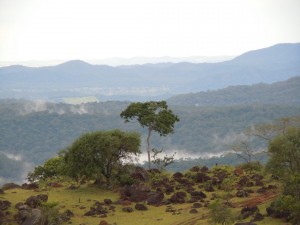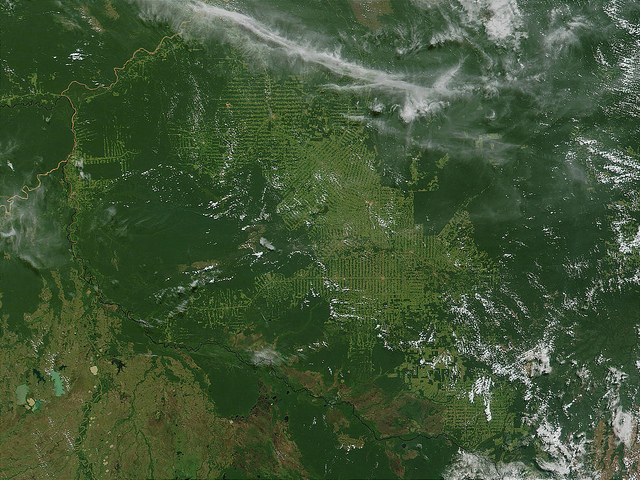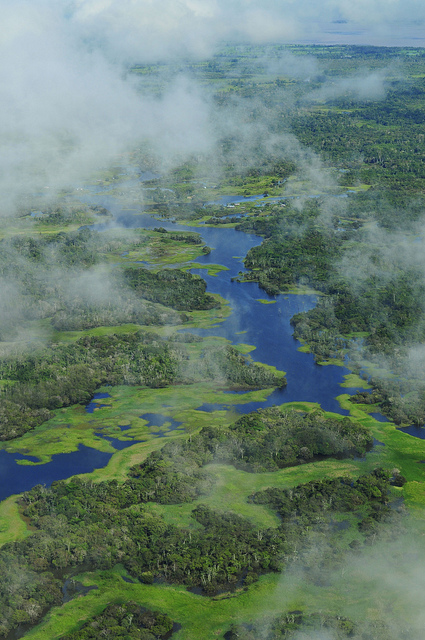Search Results for Tag: deforestation
Deforestation in Brazil jumps about 29% – our #numberoftheweek

Brazilian Rainforest, credit: DW/Michael Wetzel
On Wednesday, the Brazilian government released statistics showing that the destruction of the world’s largest rainforest jumped 29% last year. According to satellite data, 5,891 sq km of forest disappeared in the 12 months leading up to the end of July 2013. That is the equivalent of the size of the country of Puerto Rico.
One reason for the rebound in the deforestation rates is illegal logging, but also big infrastructure projects in the Amazon, such as roads and hydroelectric dams. The not-so-bad news here is that the 2013 figure is still the second-lowest annual loss recorded by the Brazilian government since it began tracking deforestation in 2004. Back then almost 30,000 sq km of forest was lost.
The below graph shows the deforestation rate from 2004 until today, provided by the Instituto Nacional de Pesquisas Espaciais (INPE). On this page you will also find more detailed information in the organization’s report, but it helps a lot if you understand português do Brasil.
Deforestation means less hydropower

Satellite image of the Rondonia region of Brazil showing the massive deforestation underway in the south-central Amazon Basin. (Photo: CC BY 2.0: Banco de Imágenes Geológicas)
The Amazon deforestation rate rocketed to 88 percent during the last year: From August 2012 to April 2013, 606 squaremiles of forest were cut down compared with 322 square miles within the previous year, claimed as a record low.
That’s the conclusion of researchers from the National Institute of Space Research, who frequently monitor forest coverage with help of satellite images. Until recently, they could announce a slowing of deforestation. But, now it seems that the fate of one of the world’s biodiversity hotspots has changed.

Trees take more water from the ground than crops do – and release more water vapour into the atmosphere. There, it turns to rain and finally feeds hydropower plants (Photo: CC BY SA 2.0: International Center for Tropical Agriculture)
The report comes on the heels of another study: scientists recently drew a connection between deforestation and energy supply. They looked at the Xingu river region in Brazil and found that cutting trees also cuts rainfall, resulting in reduced hydropower generation. That could lead to the country’s biggest dam project, Belo Monte, delivering a third less energy.
The link between deforestation and energy supply is often ignored, according to the study. “Feasibility studies of hydropower plants typically ignore the effect of future deforestation or assume that deforestation will have a positive effect on river discharge,” it says.
Rainfall does not depend on regional forest cover in the Amazon region alone. Major tropical forested regions in Central Africa and Southeast Asia also play a major role. “This dependence could affect hydropower expansion plans of a large number of developing nations in these regions “, the study concludes.
A comprehensive inventory of Tanzania’s forests
Nearly 20% of green house gas emissions worldwide are caused by deforestation and forest degradation in developing countries. Estimating and reducing these emissions is therefore one of the key goals for the international community as the Rio+20 conference on sustainable development in June draws closer. One country attempting to do just that is Tanzania. The country is currently in the process of drawing up a comprehensive inventory of its forests as you can see in the video above by the Food and Agriculture Organization of the United Nations (FAO). The inventory is meant to help the East African country to better manage its natural resources. Today more than a third of Tanzania is forested, but almost 1% of that forest is being lost annually. The inventory will measure how much carbon is stored within Tanzania’s forests and will help the country to understand the role it can play in mitigating climate change.
French
Spanish
Indonesia’s forests in the spotlight

They’re some of the rarest and most endangered wild cats in the world, and international conservation group WWF captured them on camera. The organization snapped pictures of the Sumatran tiger, clouded leopard, marble cat, golden cat and leopard cat in a patch of forest between a wildlife sanctuary and a national park.
The pictures are stunning, but they present a big problem: the wild cats were photographed in an unprotected forest area that’s being lost to deforestation. That’s why the organization is calling on the Indonesian government to step up efforts to protect its forests. Some of the big companies that surround the forest are wood suppliers, and that’s put much of the land in danger.
WWF has more pictures and information on the endangered animals
Cooking smoke a greater killer than Malaria
Lots of money and effort has gone into awareness raising, public health campaigns and law suits in a bid to wean the world off smoking. Lots of money and effort also continues to go into the prevention and treatment of malaria. But there’s another type of smoke that some three billion people around the globe can’t escape and that, according to recent findings, kills more than Malaria.
According to the World Health Organization almost half the world’s population cook their food and heat their homes using open fires or leaky stoves that run on wood, coal or biomass. And nearly two million people die prematurely as a result of inhaling the smoke day in and day out. That makes it a greater killer than malaria. Women and children are particularly affected as they tend to spend more time at home while men are working outside.
But there are also other problems with open wood fires. They emit CO2 and the wood used for cooking is often logged unsustainably. GLOBAL IDEAS has reported on clean and safe alternatives.
Efficient stoves in Peru Click here to learn more
Solar cookers in India Click here to learn more








Feedback